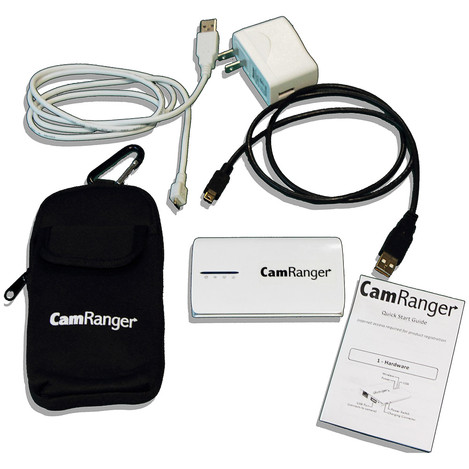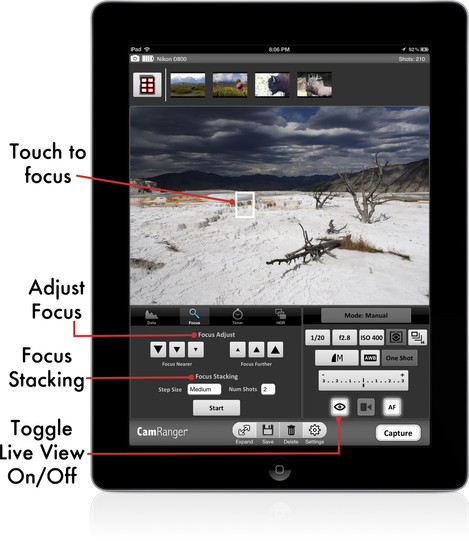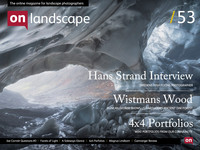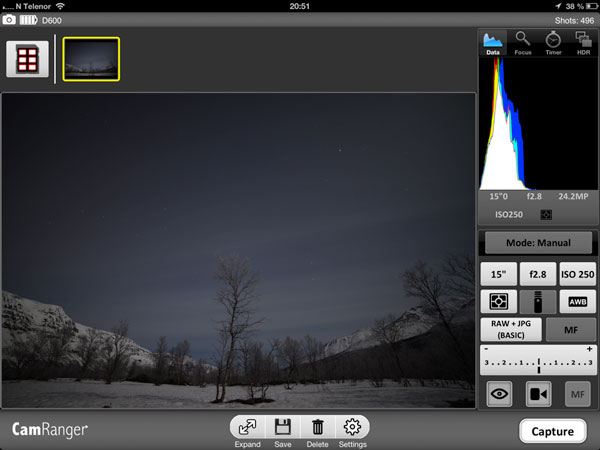Wireless Tethered Viewing

Tim Parkin
Amateur Photographer who plays with big cameras and film when in between digital photographs.
 Ever since the retina iPhone and especially the iPad came out people have wondered about (lusted after!) the ability to tie them directly to the preview, or preferably the live view, of their cameras. This is particularly true for landscape photographers where the taking and composing of the image is usually a more sedate affair allowing for meticulous attention to detail.
Ever since the retina iPhone and especially the iPad came out people have wondered about (lusted after!) the ability to tie them directly to the preview, or preferably the live view, of their cameras. This is particularly true for landscape photographers where the taking and composing of the image is usually a more sedate affair allowing for meticulous attention to detail.
Well we might just have seen the democratisation of this idea with a US company called CamRanger, essentially a home brewed effort by a husband and wife team Dave and Melissa Pawlowski. They developed the device to ‘scratch their own itch’ in taking pictures of themselves kayaking where obviously remote operation is pretty difficult. This explains the excellent signal that the device can give which we will come onto later.
What do you get in the package? Well essentially it’s a small battery powered box that has ethernet and usb connections. The USB connection plugs into your camera via the usual cable - they have the option of supplying the special ‘large’ usb connector cable for Nikon cameras - and that’s it as far as the camera is concerned.
The first thing to do is install your iPad or iPhone app and then register your CamRanger device - a step to stop other people hijacking your camranger I imagine - which you do by entering a serial number into your iPhone or iPad app (serial number is under the battery).
Once this is done you can connect to your CamRanger’s wireless signal using the serial number based wireless password provided and you’re ready to go.
We’ve made a short video of the device being used on an iPad and an iPhone which is intended to show the way the device is used, it isn’t high enough resolution to show the quality but that will come in our follow up review where we use the CamRanger in anger in Iceland.
We found setting up the device incredibly easy apart from one problem. Initially, we couldn’t get our device to work with focus bracketing on Robin Hudson's Canon 5D3 but once we reset the camera settings to defaults it all worked fine. Some setting is obviously blocking it - I think it’s probably the live view focus mode.
 Once set up the whole device worked just as expected. The only thing that wasn’t immediately obvious was how the focus and exposure bracketing worked so we’ll talk about them separately.
Once set up the whole device worked just as expected. The only thing that wasn’t immediately obvious was how the focus and exposure bracketing worked so we’ll talk about them separately.
The HDR exposure bracketing you would expect to work in the same way bracketing on a camera would work but it doesn’t - it starts at the darkest exposure and steps more open or slower.
For the focus bracketing the steps are a little more confusing and possibly not very intuitive. You focus on the nearest point and then tell it whether to take small, medium or large steps further away from this point and how many of those steps to take.
It would be a lot nicer if you could pick the far and near point and then how many steps between but I think this is a limitation of the camera rather than the CamRanger device so we’ll forgive it. Perhaps the developers could allow the possibility of calibrating our lens/camera combinations somehow - for the future possibly.
We also tried the CamRanger on Joe Cornish’s D800 and although all of the functions worked as well as the 5D3 the resolution of the live view wasn’t as good by a long stretch but without confirming this you’ll have to wait until out until our follow up. At the moment the live view for Canon cameras is a lot better.
This may be to do with the native resolution of live view output via USB. For the Canon 5D Mark 3 it’s 960x640 and on the D800 it’s 640x480 (cropped) and remember that the 100% live view on the D800 interpolates every other row so that gives you even less resolution.
If we want really high resolution then we need to use the HDMI out which can export up to 1920x1080 pixel resolution. Maybe in the future although I think we’re more likely to see cameras up the USB output before that happens.
So what did we think of the CamRanger? Well for a first iteration of what will undoubtedly be a device with a long future I’d say it’s pretty damned impressive. With Canon cameras at least it doesn’t dissapoint apart from perhaps a little lag in the view which would likely only affect those shooting fast moving wildlife like cows or sheep perhaps..
The one thing that I would like to see improved, that should be a fairly trivial change to the app software, is to make a proper ‘full screen’ view that allows you to drag the basic controls on and off the side of the screen. At the moment the closest you can get is about 80% ish of full screen.
We’ll be making a final test of the device in Iceland over the coming weeks on a Nikon D800 and a Canon 1DX (which has the same USB resolution as the 5D3) and will be bringing you high resolution video of the device attached to both cameras.
If you have any suggestions on what you would like to see us try - please add a comment.
UPDATE: Robin Hudson asked if there was anyway to do 'depth of field preview' and a colleague John Schwaller asked the creators and there was the hint that it may happen..
UPDATE: David Reid points out that the wireless transmitter for the Canon 5D2 had the ability to stream live view via a browser which works fine on any device (reports of occasional out of memory crashes aside - possibly only old iOS versions though) although the latest incarnation of 5D3 WTF is a little clunky. The advantage of the CamRanger is the ease of use, price and ability to use a native app. If only Canon had built this into cameras a while back they could have owned this space.. . David also sent a link to a tutorial .. Thanks David!


